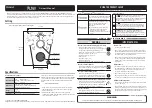
Manual No. OM5000
Jan X/04 Ver 1.40
31
6.1.7 SYNC SWEEP DELAY
- Occasionally, when the material being gaged is relatively thick (or
its ultrasonic velocity is relatively low), the SYNC SWEEP DELAY (Delay Sync) feature now can
be used to selectively "move" (position) the A-scan for improved observation of the first back
surface echo and the IP.
To operate in Delay Sync, set the SYNC SWEEP switch to the DELAY position. Then, adjust the
DELAY ADJ control and SCOPE SWEEP SPEED control in conjunction with one another until an
adequately-expanded first back surface echo is displayed at a desirable location along the scope
A-scan trace. See Figure 17.
During the initial operational setup, it will be necessary to go back and forth between the IP and
SYNC SWEEP DELAY. Once the NovaScope is set up and calibrated, it is optional as to whether
or not to use SYNC SWEEP DELAY continuously during the gaging procedure.
6.1.8 Setting DAMP Control
- The Damping control is adjustable in one ohm increments.
Carefully and slowly adjust the DAMP control to optimize the shape of the IP and first back echo
(the temporary use of manual Receiver Gain, instead of AGC is preferred during this important
adjustment). Also, the Sweep Sync Delay function should be used whenever needed to enhance
the display of the first back surface echo.
The setup is optimized when it has (1) the shortest first back surface echo pulse length (fewest
half-cycles), (2) the sharpest risetime on leading first half-cycle of the back surface echo, (3) the
least baseline noise immediately following IP and just prior to the first back surface echo, (4) the
least overall echo distortion, and (5) a relatively high echo amplitude. See Figure 18. Note that
the temporary use of the optional RF VIDEO display can be helpful when setting the DAMP
control.
While very slowly rotating the DAMP control, all of the above-mentioned optimum waveshape
characteristics typically tend to occur almost simultaneously - making it relatively easy to detect
when the DAMP control is properly adjusted. This usually occurs somewhere within the first 50%
rotation of the DAMP control from its full CCW position.
When gaging certain attenuative materials that require particularly high sensitivity, it is sometimes
helpful to rotate the DAMP control further CW than normal. This procedure adds extra
energy/amplitude to the IP for increased sensitivity. It also tends to reduce resolving power and
precision; however, this is normally not a factor for the types of applications requiring this special
DAMP adjustment.
6.1.9 Setting IP-GATE
- Set GATE DISPLAY switch to the IP position. Adjust the IP control until
the IP-Gate is slightly (but safely) beyond any IP noise or surface echo noise. This will block IP
noise from affecting the T-Gate, as shown earlier in Figure 13(a).
6.1.10 Setting T-GATE
- Set the GATE DISPLAY selection switch to the "T" position to display
the T-Gate (the IP-Gate setting in 6.1.9 remains operative even though not displayed). The T-
Gate should now extend precisely from the IP to the first back surface echo, as shown in Figure
19. If the T-Gate doesn't synchronize properly, try refining the adjustments.
















































